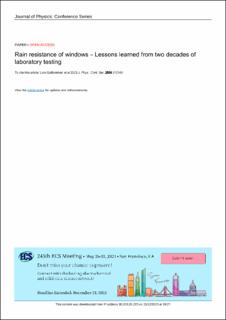| dc.contributor.author | Gullbrekken, Lars | |
| dc.contributor.author | Gransjøen, Therese | |
| dc.contributor.author | Andenæs, Erlend | |
| dc.contributor.author | Time, Berit | |
| dc.contributor.author | Kvande, Tore | |
| dc.date.accessioned | 2023-12-20T06:56:51Z | |
| dc.date.available | 2023-12-20T06:56:51Z | |
| dc.date.created | 2023-12-15T10:29:40Z | |
| dc.date.issued | 2023 | |
| dc.identifier.citation | Journal of Physics: Conference Series (JPCS). 2023, 2654 . | en_US |
| dc.identifier.issn | 1742-6588 | |
| dc.identifier.uri | https://hdl.handle.net/11250/3108284 | |
| dc.description.abstract | Windows are important in buildings intended for human activities as they let in daylight and provide views. However, they may also be vulnerable in terms of heat loss, air leaks, rain tightness, and durability. In Nordic climates featuring severe driving rain exposure, water tightness is of outmost importance. SINTEF has for many decades been testing windows as part of the Norwegian yearly product control. Air permeability and water tightness are tested according to NS-EN 1026 and NS-EN 1027, respectively. The windows are then classified as described in NS-EN 12207 and NS-EN 12208. This paper summarises experiences from the last two decades of testing, presenting the results of 1130 tests of windows' air permeability and rain tightness. The overall trend is that air and rain tightness performance of the windows have improved over time. Certain hinge configurations are clearly better than others, with tilt and turn windows performing the best and top hung casement windows the poorest. There is a clear trend that highly rainproof windows also exhibit lower air permeability. Multiple-window screens fail the test more often since they feature longer perimeters of opening. The contribution of weather sweep seals to the water tightness is significant as it makes an extra rain barrier to the joint between casement and frame. In general, leakage between the frames of double windows and in the joints of the frame occurs at lower air pressures than leakages between casement and frame. The lessons learned from the survey may guide future development of weatherproof windows. | en_US |
| dc.language.iso | eng | en_US |
| dc.publisher | IOP Publishing Ltd. | en_US |
| dc.rights | Navngivelse 4.0 Internasjonal | * |
| dc.rights.uri | http://creativecommons.org/licenses/by/4.0/deed.no | * |
| dc.title | Rain resistance of windows – Lessons learned from two decades of laboratory testing | en_US |
| dc.type | Peer reviewed | en_US |
| dc.type | Journal article | en_US |
| dc.description.version | publishedVersion | en_US |
| dc.subject.nsi | VDP::Teknologi: 500 | en_US |
| dc.source.pagenumber | 10 | en_US |
| dc.source.volume | 2654 | en_US |
| dc.source.journal | Journal of Physics: Conference Series (JPCS) | en_US |
| dc.identifier.doi | 10.1088/1742-6596/2654/1/012140 | |
| dc.identifier.cristin | 2214029 | |
| dc.relation.project | Norges forskningsråd: 237859 | en_US |
| dc.source.articlenumber | 012140 | en_US |
| cristin.ispublished | true | |
| cristin.fulltext | original | |
| cristin.qualitycode | 1 | |

